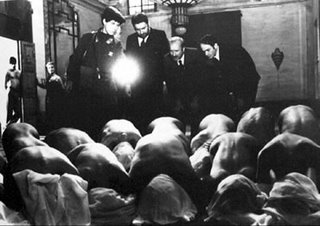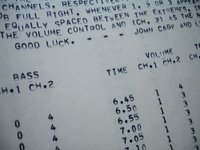Desire Line

Labels: art, collaboration, composition, dance, music, thom blum, tune of the day

Labels: art, collaboration, composition, dance, music, thom blum, tune of the day
A favorite moment from The Bed You Sleep In, where Thomas Morris as the oracle has just hinted at Ray's impending doom. He recites a bit of Revelation 14 and we head off on one of Jon's landscape love-ins. Jon told me that the location of a story was as important to him as plot or character and deserved equal time. The music that starts about one minute into the clip is almost entirely derived from field recordings that Josh Rosen and I made of the local sawmill in Toledo, Oregon, now closed down because, as they discuss in the movie, you can't get any of the big trees anymore. (And why not, you ask? Because they really did clearcut the whole state and ship the uncut trees off to Japan.) But the sawmill was a beautiful aural environment. Walking through it was like listening to a futurist symphony and the raw recordings were beautiful, but of course I felt like I had to prettify it all a bit, and I think I was successful in that. I've bumped up the volume of the music in the clip so that it is a bit more intense, but you can hear the original music here or on the full soundtrack recording here.
Labels: collaboration, composition, film, jon jost, music, religion

Labels: art, artaud, collaboration, composition, jim bisso, opera, pasolini, sade, sexuality
 Let's take a moment to consider one of my favorite paintings. In the collection of the artist. I have a few of Amy's prints above my piano just below Vera where I meditate on them while I work. In a quid pro quo, she at times listens to The Bed You Sleep In in between the blues and the hokum when she is working. It makes me happy to think that, possibly, I've left a small impression. Maybe a brush stroke that took a small turn to reflect a particularly lovely note on the viola, maybe a color that ended up a slightly darker hue as a static sad sawmill loop sounded.
Let's take a moment to consider one of my favorite paintings. In the collection of the artist. I have a few of Amy's prints above my piano just below Vera where I meditate on them while I work. In a quid pro quo, she at times listens to The Bed You Sleep In in between the blues and the hokum when she is working. It makes me happy to think that, possibly, I've left a small impression. Maybe a brush stroke that took a small turn to reflect a particularly lovely note on the viola, maybe a color that ended up a slightly darker hue as a static sad sawmill loop sounded.Labels: amy crehore, art, collaboration, lynne rutter
Labels: collaboration, composition, mordake, opera
 When I was on the steering committee of the San Francisco Chapter of the American Composers Forum, I suggested that we have a composer-composer collaboration grant, similar to our composer-writer and composer-choreographer grants. This proposal was met by some skepticism if not derision by my fellow committee members. Most of them couldn't imagine that anyone would desire to apply for such a thing, but as a youth, I was very familiar with a few famous examples of such collaborations. One was John Cage and Lejaren Hiller's HPSCHD, released on a Nonesuch LP, each copy of which contained a unique set of instructions printed on a somewhat jittery high speed line printer of the day, that instructed the listener, at five second intervals, where to set the controls on their stereo for an added bit of liveliness, although it required a stereo with separate tone controls per channel and more that 2 hands to accomplish. The piece seemed to be a true collaboration, and may have worked well as Hiller and Cage both had an interest in chance and complexity. In an interview years later with Vincent Plush, Hiller discussed having first suggested the use of the famous Mozart-attributed dice game pieces and Cage using the I-Ching to make substitutions and that
When I was on the steering committee of the San Francisco Chapter of the American Composers Forum, I suggested that we have a composer-composer collaboration grant, similar to our composer-writer and composer-choreographer grants. This proposal was met by some skepticism if not derision by my fellow committee members. Most of them couldn't imagine that anyone would desire to apply for such a thing, but as a youth, I was very familiar with a few famous examples of such collaborations. One was John Cage and Lejaren Hiller's HPSCHD, released on a Nonesuch LP, each copy of which contained a unique set of instructions printed on a somewhat jittery high speed line printer of the day, that instructed the listener, at five second intervals, where to set the controls on their stereo for an added bit of liveliness, although it required a stereo with separate tone controls per channel and more that 2 hands to accomplish. The piece seemed to be a true collaboration, and may have worked well as Hiller and Cage both had an interest in chance and complexity. In an interview years later with Vincent Plush, Hiller discussed having first suggested the use of the famous Mozart-attributed dice game pieces and Cage using the I-Ching to make substitutions and thatLabels: collaboration, composition